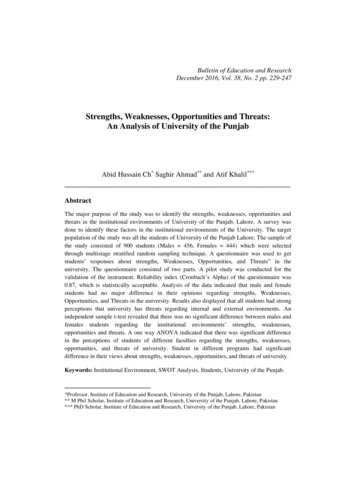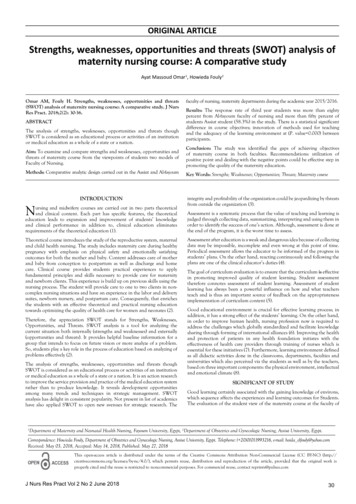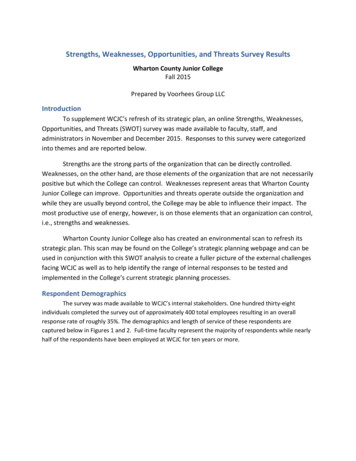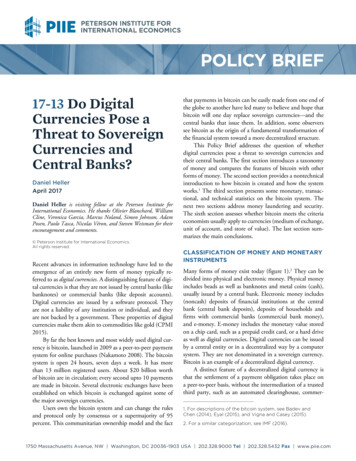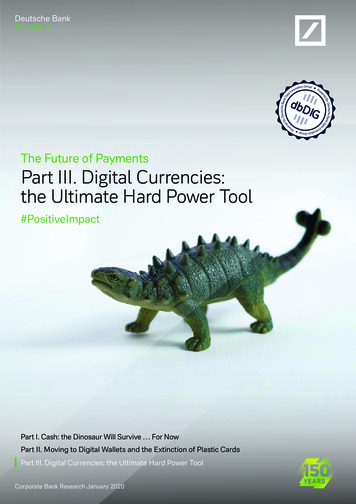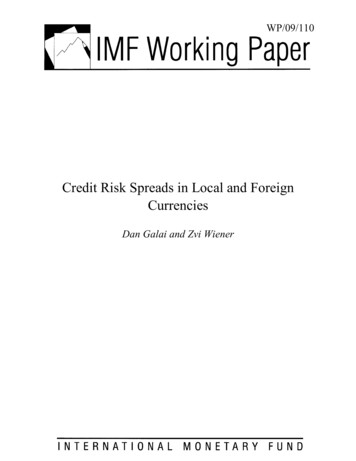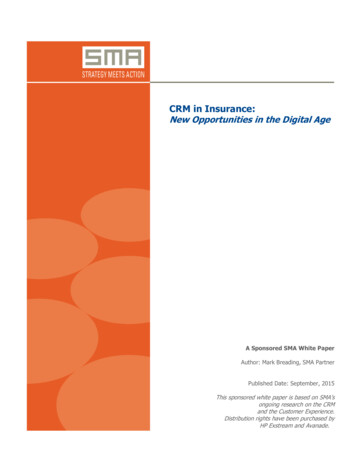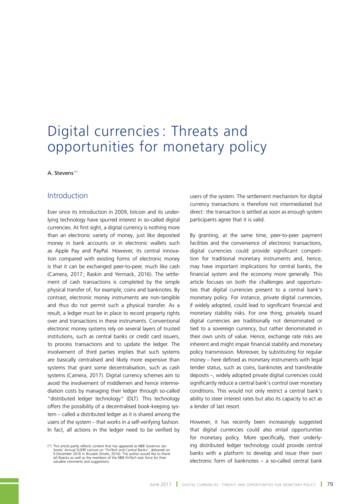
Transcription
Digital currencies : Threats andopportunities for monetary policyA. Stevens (*)IntroductionEver since its introduction in 2009, bitcoin and its underlying technology have spurred interest in so-called digitalcurrencies. At first sight, a digital currency is nothing morethan an electronic variety of money, just like depositedmoney in bank accounts or in electronic wallets suchas Apple Pay and PayPal. However, its central innovation compared with existing forms of electronic moneyis that it can be exchanged peer-to-peer, much like cash(Camera, 2017 ; Raskin and Yermack, 2016). The settlement of cash transactions is completed by the simplephysical transfer of, for example, coins and banknotes. Bycontrast, electronic money instruments are non-tangibleand thus do not permit such a physical transfer. As aresult, a ledger must be in place to record property rightsover and transactions in these instruments. Conventionalelectronic money systems rely on several layers of trustedinstitutions, such as central banks or credit card issuers,to process transactions and to update the ledger. Theinvolvement of third parties implies that such systemsare basically centralised and likely more expensive thansystems that grant some decentralisation, such as cashsystems (Camera, 2017). Digital currency schemes aim toavoid the involvement of middlemen and hence intermediation costs by managing their ledger through so-called“distributed ledger technology“ (DLT). This technologyoffers the possibility of a decentralised book-keeping system – called a distributed ledger as it is shared among theusers of the system – that works in a self-verifying fashion.In fact, all actions in the ledger need to be verified by(*) This article partly reflects content that has appeared as NBB Governor JanSmets’ Annual SUERF Lecture on “FinTech and Central Banks“, delivered on9 December 2016 in Brussels (Smets, 2016). The author would like to thankJef Boeckx as well as the members of the NBB FinTech task force for theirvaluable comments and suggestions.June 2017 users of the system. The settlement mechanism for digitalcurrency transactions is therefore not intermediated butdirect : the transaction is settled as soon as enough systemparticipants agree that it is valid.By granting, at the same time, peer-to-peer paymentfacilities and the convenience of electronic transactions,digital currencies could provide significant competition for traditional monetary instruments and, hence,may have important implications for central banks, thefinancial system and the economy more generally. Thisarticle focuses on both the challenges and opportunities that digital currencies present to a central bank‘smonetary policy. For instance, private digital currencies,if widely adopted, could lead to significant financial andmonetary stability risks. For one thing, privately issueddigital currencies are traditionally not denominated ortied to a sovereign currency, but rather denominated intheir own units of value. Hence, exchange rate risks areinherent and might impair financial stability and monetarypolicy transmission. Moreover, by substituting for regularmoney – here defined as monetary instruments with legaltender status, such as coins, banknotes and transferabledeposits –, widely adopted private digital currencies couldsignificantly reduce a central bank‘s control over monetaryconditions. This would not only restrict a central bank‘sability to steer interest rates but also its capacity to act asa lender of last resort.However, it has recently been increasingly suggestedthat digital currencies could also entail opportunitiesfor monetary policy. More specifically, their underlying distributed ledger technology could provide centralbanks with a platform to develop and issue their ownelectronic form of banknotes – a so-called central bankDigital currencies : Threats and opportunities for monetary policy 79
digital currency (CBDC) (1). Different arguments can becited as to why a central bank might consider issuingsuch a CBDC. For instance, adopting a sovereign digitalcurrency could be an appropriate policy response to curbthe risks of private initiatives mentioned above ; at leastto the extent that there are reasons to presume that suchrisks would be relevant. Another often stated argumentis that a CBDC could help to relax the effective lowerbound constraint on nominal interest rates, permittingthe central bank to implement negative policy rates if thatwere warranted by economic circumstances. Such arguments, however, should be set against the implications ofsovereign digital currencies for the banking system – andthese appear to be highly uncertain. On the one hand, byproviding competition for bank deposits, the adoption ofa CBDC could limit the practice of fractional reserve banking, making for a safer financial system, with less scopefor impairment in monetary policy transmission. Yet onthe other, too widespread a substitution of bank depositsby CBDC could lead to a significant de-funding of thebanking sector, with negative spillover effects on creditcreation and monetary policy.The article proceeds as follows. Section 1 sets thestage, briefly sketching out the language we will useto describe non-physical types of money. Subsequently,section 2 discusses the potential challenges imposedby privately issued digital currencies for the conduct ofmonetary policy. The opportunities for monetary policyassociated with a potential adoption of sovereign digitalmoney are discussed in section 3. The final section setsout our conclusions.The above definitions are fairly broad : they are not necessarilylinked to any legal terminology and do not depend on features other than the underlying technology, such as the denomination of the currency (sovereign or another referenceunit) or its issuer (public or private entity). Any referenceto such additional features will be spelled out clearly. Forinstance, the prefixes “private“ and “central bank“ serve toclarify the type of issuer of a digital currency.1. Some definitions2. Potential risks of privately issuedAs noted by Camera (2017), no clear consensus exists onthe language used to describe money components thatlack the physical structure of cash. For instance, throughout the literature, different interpretations are given tothe concepts “e-money“, “digital money“, “crypto currency“ and “virtual currency“. Sometimes these termsare used interchangeably (as, for instance, in Fung andHalaburda, 2016). In other publications, they refer to rather distinct forms of money, depending on the criteria applied to classify non-physical types of money instruments.In this article, we adopt the definitions proposed byBarrdear and Kumhof (2016), which largely correspond(1) The term “central bank digital currency“ was first used by Broadbent (2016).(2) The definitions applied by the Bank of England can be found athttp : / / www.bankofengland.co.uk / research / Pages / onebank / cbdc.aspx.(3) See https : / / www.ecb.europa.eu / stats / money credit banking / electronicmoney / html / index.en.html.80to the official terminology used by the Bank of England (2).Their classification basically depends on the technologyunderpinning the currency instrument. Against this background, “electronic money“ (e-money) is broadly definedas monetary value stored in an electronic device thatcan be used to make payments – much in line with thedefinition used by the Bank for International Settlements(BIS, 2015) ; in brief : any intangible type of money that isbased on computer technology. Note that this definitionis broader than the legal definition of e-money as specified in EU legislation (3). The term “digital currency“ is usedto refer to any electronic form of money that features adistributed ledger and a decentralised payment system.“Cryptocurrencies“ are defined as a separate sub-classof digital currencies, with their distinguishing featuredepending on the consensus mechanism applied forupdating the ledger (for more details, see Barrdear andKumhof, 2016). To simplify matters, we ignore the rolethat specific technical modalities of the distributed ledgertechnology – such as the consensus mechanism – mightplay for the economics of digital currencies. In what follows, we therefore only make reference to the more general notion of digital currencies. Digital currencies : Threats and opportunities for monetary policydigital currencies to monetary policyThe potential risks of private digital currencies for monetary policy have been well described in – amongst others – a recent article by Ali et al. (2014). Inspired by apolicy brief by Lo and Wang (2014), assessing whetherbitcoin can be regarded as a currency instrument, thischapter recasts many of the arguments of Ali et al. (2014)by thinking about the performance of a digital currencyin serving the three traditional functions of money : first,money is considered as an instrument that facilitates tradeby acting as a medium of exchange – i.e. money can beused for buying and selling goods and services. Second,money acts as a store of value in that it is a convenientway to store wealth – i.e. money can be used to transferpurchasing power from the present to the future. Finally,money serves quantification purposes as a unit of account – i.e. money is the common standard for measuringthe relative worth of goods and services. NBB Economic Review
In line with the literature, this section concludes that policy challenges are likely to be limited if private digital currencies only serve as a medium of exchange. In contrast,when these currencies are additionally regarded as a goodstore of value and – even more importantly – are also usedas a unit of account, both monetary and financial stabilityrisks may loom larger.2.1Low risks if private digital currencies onlyserve as a medium of exchangeAs long as private digital currencies are merely used asa medium of exchange and are not considered as a unitof account or as a store of value, they should not posesignificant threats to monetary policy. In principle, in thiscase, digital currencies work in a similar fashion to prepaid types of e-money instruments (e.g. electronic walletssuch as Apple Pay and PayPal). More specifically, digitalcurrencies are only put “into circulation“ when regularmoney is exchanged by the user who intends to use it ina transaction, and, likewise, digital currency is absorbed(withdrawn from circulation) and exchanged back to traditional money as soon as the transaction is settled.Consequently, in this scenario, a digital currency‘s net effect on the amount of money used for transactions shouldbe limited, implying that the central bank maintains itsability to influence the money supply, short-term interestrates, and, hence, aggregate demand. In fact, the regularcurrency and the interest rate on it remain the dominantmonetary guideposts, also when it comes to financingexpenditure, whereas the digital currency only serves asa means of transaction. Moreover, when only used as amedium of exchange, a digital currency‘s price should,in theory, not be prone to too much volatility – preciselybecause its circulation depends on demand for it, and noton any speculation about its future price (which could bethe case if the currency also served as a store of value).The steadily growing list of merchants accepting payments in bitcoin (the most well-known private digitalcurrency) suggests that private digital currencies have thepotential to be widely accepted as payment for a sufficiently large set of goods or services (1). A 2014 study byLo and Wang shows that retailers accepting bitcoin payments do not charge a premium and may in fact offer adiscount (albeit typically a small one) on purchases madewith bitcoin. This finding suggests that the peer-to-peerpayment services provided by digital currencies – avoiding(1) See, for example, the website Coinmap for an interactive map showing allphysical stores around the world accepting bitcoin as a payment instrument.(2) Bitcoin intermediaries such as Coinbase offer such hedging services.June 2017the fees charged by traditional payment providers – mightfulfil these currencies‘ potential to lower transaction costs.However, at the same time, this study also suggests thatdigital currencies serve (so far) poorly as a store of value oras a unit of account. In fact, because the value of privatedigital currencies is traditionally not tied to a sovereigncurrency, their prices can be very volatile, as illustrated inchart 1 for bitcoin. Consequently, to avoid price volatilityand associated distorted price signals, most merchantsaccepting bitcoin payments post their official prices in sovereign reference units (e.g. euros, dollars, etc.). Moreover,to fully reap the potential benefits of reduced paymentprocessing costs, merchants hedge against potential exchange rate volatility. For instance, the check-out pricein bitcoin is frequently updated (e.g. every ten to fifteenminutes) so as to maintain a relatively stable price whenexpressed in euros, whereas bitcoins paid are immediatelyconverted back into euros (2).2.2Financial stability risks if private digitalcurrencies also serve as a store of valueIncreased financial stability risks and associated impairments in monetary policy transmission could emerge ifprivate digital currencies were widely perceived as goodstores of value, as such perceptions are unfounded. In fact,private digital currencies lack the elements of traditionalstores of value that would render them safe vehicles fortransferring wealth from the present to the future. Forinstance, in contrast to commodities (such as oil and gold),private digital currencies have no intrinsic value : intrinsically, they are nothing more than lines of computer code.Neither do private digital currencies carry any legal value,in that they are not backed by a sovereign entity as is theChart 1THE VALUE OF BITCOIN(US dollar per bitcoin)1 6001 4001 2001 000800600400200020112012201
a medium of exchange and are not considered as a unit of account or as a store of value, they should not pose significant threats to monetary policy. in principle, in this case, digital currencies work in a similar fashion to pre-paid types of e-money instruments (e.g. electronic wallets such as Apple pay and paypal). more specifically, digital

